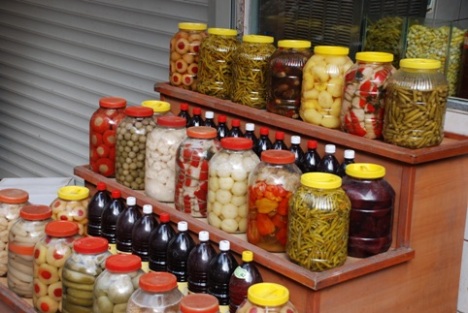
Shines like a jewel after 6 days
I usually have conflicting feelings when T. asks me something about cooking. “How do I cut the onions?” is innocent enough, he is my kitchen assistant, and I very gracefully sometimes let him take care of the lower tasks. Examples being cutting the guanciale and the bread, washing the greens – have you seen how much dirt comes from that spinach? – and reaching for things that are higher up.

coarse salt, sugar, herbs
A totally different story it is when he asks, seemingly innocently as we wait our turn at the fish stand (“bionda”, blondie, is what everyone gets called here), something like “how do you make the gravlax?”. Instantly, I have voices inside my head. What, you don’t have voices inside your head when you are cooking? “Why does he want to know? What does he plan? Is he thinking he can make the dish himself? Why is he so self-esteemed all at once? Ha, he needs to peel a ton of potatoes before he can cook a dish alone.” And, most importantly: “Sh**! He is going to see how easy it is to produce something so show-stopping!”

bed the salmon in the mixture
Because easy and show-stopping and delicious it is! There are 100 ways to use it, too: drape slices over potatoes or blinis with some creme fraiche-horseradish mix, put pieces&bits into scrambled eggs, combine with zucchini for a delish pasta sauce…..

weigh it down with a matching wine!
So, now go buy the freshest piece of salmon you can lay your hands on, with half of it make Nicky’s Salmon tartare for instant gratification while you wait (the only difficulty in making gravlax!) for the rest to turn into jewels!
Gravlax (Graved lax)
ancient method, own mix
prep: 20 mins
unattended: 6 days
Salmon fillets, freshest possible, without skin
coarse salt, 2x the weight of the salmon
sugar, 1x the weight of the salmon
herbs (I used fennel seeds, wild fennel greens, berries and leaves of myrtle; 1tbsp of each – feel free to use a mix that you like best – dill is traditional, if that rocks your boat!)
Wash and pat dry the salmon fillets. Check for any tiny fishbones that may be in the flesh, you can easily pull them out.
Mix salt, sugar and herbs. In a deep non-reactive dish (glass or ceramic) make a thin bed with the mixture. Put the fillets on this bed and cover completely with the rest of the mixture. Put foil saran wrap/cling film (thanks for reminding me, eat!) directly on the salt mixture, put the dish in the fridge and put something as a weight on it. I strongly advice to use the wrap/film, as the mixture will get soggy and smear on whatever you are using as a weight.
On the 2nd day, the fish will already start losing liquid, the salt mixture will get sticky. Check to see if you need to patch any bare spots. The fish has to be completely covered with the mixture throughout the process.
After 5 to 6 days the fish will be “graved”. It is hard, thinner and shiny. Bury it out of the mixture, wash quickly to get rid of the clumps of salt mixture and pat dry. Discard salt mixture! To eat, slice real thin. Will keep, packed in parchment paper, weeks in the fridge. Can also be frozen.
Update:
There has been some discussion about eating raw salmon and possible parasite infection in the comments and in emails. Here is what my research (in various government and/or research institute based sites in English and German) delivered and how I handle the situation:
* Raw fish, especially fresh water (or mixed-living) fish, can have parasites. Salmon is one of the those fish.
* The parasites live in the stomach and/or intestines of the fish when it is alive. When it dies, they go into the flesh.
* That is why fish are gutted as soon as they are caught – the worms have no time to eat themselves into the flesh. Don’t ever buy un-gutted salmon at the market.
* If some parasites (or their larvae) have found their way to the fish flesh, they are detectable with the bare eye – they are at least about 1 cm long.
* Almost none of the fish worms can’t adapt to the human system and don’t live in humans. There are no certain numbers but there have been about 200 infections in the USA in the past 27 years.
* Freezing at temperatures around -40°C (which you can’t achieve in a home freezer) and also cooking the fish kill all parasites. Hot smoking as well, but not cold smoking.
* Marinating (acids) doesn’t kill the parasites. There is uncertainty about salting. Some sources say abundant salt (as I use in my recipe as opposed to some lighter “graves” in other recipes) is enough to kill all parasites.
* All fish in Europe that are sold for explicit raw consumption have been frozen before – like in sushi restaurants.
* The fresh salmon from which I get the fillets at the market is not frozen.
* But it is very fresh, it has been gutted quickly, and I do visually examine the fillets before “graving” them with a lot of salt.
* Everyone should decide himself if he wants to eat fresh raw salmon or any other fish. I will surely keep on doing it, observing the above rules.

slice it thin - flavor explosion!
Filed under: recipes, staying in | Tagged: gravedlax, gravlax, salmon | 27 Comments »

















